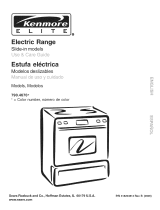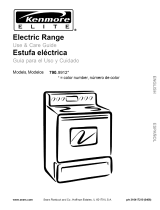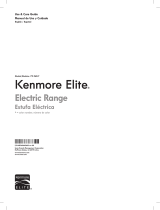
Important Safety Instructions
IMPORTANT INSTRUCTIONS FOR USING
YOUR COOKTOP
• Know which knob controls each surface heating unit. Place
a pan of food on the unit before turning it on, and turn the unit
off before removing the pan.
• Use Proper Pan Size--This appliance is equipped with one
or more surface units of different sizes. Select utensils having
flat bottoms large enough to cover the surface unit heating
element. The use of undersized utensils will expose a portion
of the heating element to direct contact and may result in
ignition of clothing. Proper relationship of utensil to element
will also improve efficiency.
• Utensil Handles Should Be Turned Inward and Not Extend
Over Adjacent Surface Elements--To reduce the risk of
burns, ignition of flammable materials, and spillage due to
unintentional contact with the utensil, the handle of the utensil
should be positioned so that it is turned inward, and does not
extend over adjacent surface units.
• Never Leave Surface Elements Unattended at High Heat
Settings--Boilovers cause smoking and greasy spillovers that
may ignite, or a pan that has boiled dry may melt.
• DO Not Immerse or Soak Removable Heating Elements--
Heating elements should never be immersed in water.
Heating elements clean themselves during normal operation.
• Glazed Cooking Utensils--Only certain types of glass, glass/
ceramic, ceramic, earthenware, or other glazed utensils are
suitable for cook top service without breaking due to the
sudden change in temperature. Check the manufacturer's
recommendations for cook top use.
• When flaming foods under a ventilating hood, turn the fan
on.
IMPORTANT INSTRUCTIONS FOR USING
YOUR OVEN
• Use Care When Opening Oven Door or Warmer Drawer (if
equipped)--Stand to the side of the range when opening the
door of a hot oven. Let hot air or steam escape before you
remove or replace food in the oven.
• Keep Oven Vent Ducts Unobstructed. The oven vent is
located under the left rear surface element if your model is
equipped with coil elements. The oven vent is located below
the backguard for models equipped with ceramic-glass cook
tops. Touching the surfaces in this area when the oven is
operating may cause severe burns. Also, do not place plastic
or heat-sensitive items on or near the oven vent. These items
could melt or ignite.
• Placement of Oven Racks. Always place oven racks in
desired location while oven is cool. If rack must be moved
while oven is hot use extreme caution. Use potholders and
grasp the rack with both hands to reposition. Do not let
potholders contact the hot heating elements in the oven.
Remove all utensils from the rack before moving.
• Do not use the broiler pan without its insert. The broiler pan
and its insert allow dripping fat to drain and be kept away from
the high heat of the broiler.
• Do not cover the broiler insert with aluminum foil. Exposed
fat and grease could ignite.
• Protective Liners--Do not use aluminum foil to line the oven
bottom. Only use aluminum foil as recommended in this
manual. Improper installation of these liners may result in risk
of electric shock, or fire.
SELF CLEANING OVENS
• Clean in the self-cleaning cycle only the parts listed in
this Use & Care Manual. Before self cleaning the oven,
remove the broiler pan and any utensils or foods from the
oven.
• Do Not Use Oven Cleaners--No commercial oven cleaner
or oven liner protective coating of any kind should be used
in or around any part of the oven.
• Do Not Clean Door Gasket--The door gasket is essential
for a good seal. Care should be taken not to rub, damage or
move the gasket.
•The health of some birds is extremely sensitive to the fumes
given off during the self-cleaning cycle of any range. Move
birds to another well-ventilated room.
IMPORTANT INSTRUCTIONS FOR CLEANING
YOUR RANGE
• Clean the range regularly to keep all parts free of grease
that could catch fire. Pay particular attention to the area
underneath each surface element. Do not allow grease to
accumulate.
• Kitchen cleaners and aerosols--Always follow the
manufacturer's recommended directions for use. Be aware
that excess residue from cleaners and aerosols may ignite
causing damage and injury.
• Clean Ventilating Hoods Frequently--Grease should not be
allowed to accumulate on the hood or filter. Follow
manufacturer's instructions for cleaning.
FOR CERAMIC-GLASS COOK TOP MODELS
• Do Not Cook on Broken Cook Top--If cook top should break,
cleaning solutions and spillovers may penetrate the broken
cook top and create a risk of electric shock. Contact a qualified
technician immediately.
• Clean Cook Top with Caution--If a wet sponge or cloth is
used to wipe spills on a hot cooking area, be careful to avoid a
steam burn. Some cleaners can produce noxious fumes if
applied to a hot surface.
IMPORTANT SAFETY NOTICE
The California Safe Drinking Water and Toxic Enforcement Act
requires the Governor of California to publish a list of
substances known to the state to cause cancer, birth defects or
other reproductive harm, and requires businesses to warn
customers of potential exposure to such substances.
























